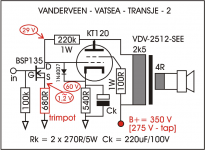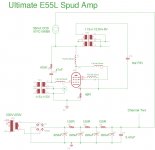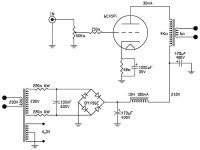Hey there fellas,
New here 'n first post.
Straight to the point: I am looking for some circuit suggestions for building/clone the simplest, most minimalistic, best sounding tube amp circuit ever made.
Which circuit of all circuits do you think get the prize? Maybe name the best 3?
I would like to have just a volume knob and maybe some sort of tone stack but "fixed" if that makes any sense, meaning no tone knobs (but that can constitute a mod later on as I build the amp, I mean getting rid of the pots)
I'm quite a noob in these fields, though very passionate about it.
Thanks you for your time,
Captain Cap.
New here 'n first post.
Straight to the point: I am looking for some circuit suggestions for building/clone the simplest, most minimalistic, best sounding tube amp circuit ever made.
Which circuit of all circuits do you think get the prize? Maybe name the best 3?
I would like to have just a volume knob and maybe some sort of tone stack but "fixed" if that makes any sense, meaning no tone knobs (but that can constitute a mod later on as I build the amp, I mean getting rid of the pots)
I'm quite a noob in these fields, though very passionate about it.
Thanks you for your time,
Captain Cap.
Last edited:
 Is this a post about a guitar amplifier or a hifi amp? If the latter rather than the former it should be moved to Instruments & Amps. The reference to "tone stack" leads me to believe it is an MI oriented question.
Is this a post about a guitar amplifier or a hifi amp? If the latter rather than the former it should be moved to Instruments & Amps. The reference to "tone stack" leads me to believe it is an MI oriented question.Otherwise welcome to the forum!
Thank you,
Sorry, I forgot to specify... it's about a hifi amp.
I come from guitar-amp-city, that's why "tone stack" lol ...how do you call it in these lands?
CC
Sorry, I forgot to specify... it's about a hifi amp.
I come from guitar-amp-city, that's why "tone stack" lol ...how do you call it in these lands?
CC
Last edited:
Cool, so it's in the right place.
Typically we refer to them as tone controls. There are various sorts, mostly commonly Baxandall both active and passive types, but there are many others.
I don't use tone controls in my designs at all. (I do use parametric room equalizers however)
You've asked a very open ended question, and you need to greatly narrow the focus to get useful answers, so to start some questions:
Typically we refer to them as tone controls. There are various sorts, mostly commonly Baxandall both active and passive types, but there are many others.
I don't use tone controls in my designs at all. (I do use parametric room equalizers however)
You've asked a very open ended question, and you need to greatly narrow the focus to get useful answers, so to start some questions:
- How much power do you need and what sort of speakers (or headphones) will you use.
- Do you want SE or PP designs?
- What is your budget?
- What do you mean by best? Technically superior, cost effective, easy to build or some combination of all of these things? Or something altogether different?
I come from guitar-amp-city, that's why "tone stack" lol ...how do you call it in these lands?
It's tone controls. The overwhelming majority of recordings do not benefit from their presence. Therefore, tone controls should be completely defeatable, as in out of the signal path, when not in use. Simple and the requirements mentioned don't go together. Forget about tone controls, at least for now.
I am looking for some circuit suggestions for building/clone the simplest, most minimalistic, best sounding tube amp circuit ever made.
Define best. IMO/IME, that's a very large "can of worms".
It is impossible to separate an amp from the speakers it will be mated to. What sort of speakers are you planning on using? Quality circuitry appropriate (power O/P, damping factor, etc.) to the speakers can be recommended after the info. is provided.
Thank you,
Sorry, I forgot to specify... it's about a hifi amp.
I come from guitar-amp-city, that's why "tone stack" lol ...how do you call it in these lands?
CC
I call them bass and treble controls as a tone control to me is a single knob. As said before most of the time it's not necessary although on my next preamp I'm including bass and treble for the first time.
Without knowing exactly what the goal is I'll start with recommending you read up in these forums, and check out tubecad.com which is a wealth of knowledge. Also surprisingly the datasheet can be a great source for a quick and dirty circuit.
I personally like a blend of simplicity and complexity (like CCS cathode bias).
This is a simple and extensible design (I've built the basic circuit with 6P1P, and 6P6S)
http://www.keith-snook.info/amplifier-hifi-schematics/Acrosound 6L6 Rebuild.pdf
Cheers
I think Mark has already defined his requirement "simplest, most minimalistic, best sounding tube amp circuit ever made" if you could consider the light-bulb as a tube of kinds. 😉
You can make an excellent 3W SE amplifier with a single triode strapped E55L. Simple and extremely linear to boot. To me this has got to be the simplest high performance amplifier available.
Shoog
Shoog
Thanks for your answers so far... Let's forget about "best" for now and let's better talk about "most famous" or revered 😉
To answer your questions Kevin,
*POWER - I don't listen to music very loud, so I don't think power will matter that much, so anywhere between 1watt and 100watts is going to be ok I guess... as long as I have a volume control 😉
*SE or PP - Single Ended can be simpler but I'm ok with using a Push Pull circuit. I like PP in guitar amps, but I'm guessing hifi amplifiers is a whole 'nuther story.
*BUDGET - Anywhere between US$1 and US$5000
*BEST - Most revered circuit design basically. Maybe "most natural sounding" might be a synonym for my concept of "best".
Someone asked about with which speakers am I going to pair it with... maybe/hopefully top of the line Tannoy?
I want to build the amp first and then try it with different speakers. So let's leave speakers out of the equation for now.
Thanks,
CC
Cool, so it's in the right place.
Typically we refer to them as tone controls. There are various sorts, mostly commonly Baxandall both active and passive types, but there are many others.
I don't use tone controls in my designs at all. (I do use parametric room equalizers however)
You've asked a very open ended question, and you need to greatly narrow the focus to get useful answers, so to start some questions:
I suspect you will get many answers and yet no answers. I don't think there is a "best" just something that suits a particular set of requirements well, but there are always other choices that will do the job as well/better or perhaps even focus on a specific requirement to the detriment of other performance metrics to someone's specific preferences.
- How much power do you need and what sort of speakers (or headphones) will you use.
- Do you want SE or PP designs?
- What is your budget?
- What do you mean by best? Technically superior, cost effective, easy to build or some combination of all of these things? Or something altogether different?
To answer your questions Kevin,
*POWER - I don't listen to music very loud, so I don't think power will matter that much, so anywhere between 1watt and 100watts is going to be ok I guess... as long as I have a volume control 😉
*SE or PP - Single Ended can be simpler but I'm ok with using a Push Pull circuit. I like PP in guitar amps, but I'm guessing hifi amplifiers is a whole 'nuther story.
*BUDGET - Anywhere between US$1 and US$5000
*BEST - Most revered circuit design basically. Maybe "most natural sounding" might be a synonym for my concept of "best".
Someone asked about with which speakers am I going to pair it with... maybe/hopefully top of the line Tannoy?
I want to build the amp first and then try it with different speakers. So let's leave speakers out of the equation for now.
Thanks,
CC
Last edited:
You can make an excellent 3W SE amplifier with a single triode strapped E55L. Simple and extremely linear to boot. To me this has got to be the simplest high performance amplifier available.
Shoog
Can you link/post some schematics please?
I don't want to design an amp, just clone a great trusted circuit and maybe add some simple mods 😉
If you don't mind a (mos)trasistor, this one ?
You could do the same kind of thing with other output tubes.
Mona
Looks nice though I would prefer a full tube circuit, maybe with a small preamp stage instead of that transistor (the transistor seems to be acting as some sort of preamp stage right?)
CC
Last edited:
Probably the simplest amp to build is an SE amp of say 3 to 8 watts output, followed by a cathode biased push pull amp of say 15 to 25 watts (but even that is debatable).
What you might end up looking for is someone's design/build of an SE amp and cathode biased PP amp and see which one you prefer, looking at their specs as part of your decision. SE amps need more attention in the power supply to get the ripple down, while PP amps are less stringent in that regard. But PP amps on the other hand need a phase inverter.
Which is the most natural sounding? That is a hot debate that will never be answered. To one who favors mid range clarity, natural sounding may be totally different than for someone else who favors bass response, for example.
What you might end up looking for is someone's design/build of an SE amp and cathode biased PP amp and see which one you prefer, looking at their specs as part of your decision. SE amps need more attention in the power supply to get the ripple down, while PP amps are less stringent in that regard. But PP amps on the other hand need a phase inverter.
Which is the most natural sounding? That is a hot debate that will never be answered. To one who favors mid range clarity, natural sounding may be totally different than for someone else who favors bass response, for example.
I designed one myself but can't point to any other proven example.Can you link/post some schematics please?
I don't want to design an amp, just clone a great trusted circuit and maybe add some simple mods 😉
Shoog
Attachments
If you don't mind a (mos)trasistor, this one ?
You could do the same kind of thing with other output tubes.
Mona
That looks an awful lot like this:
http://www.diyaudio.com/forums/tubes-valves/136179-schadeode.html
One possible candidate is Nelson Pass's amplifier called De-Lite (link) which has only one transistor. If minimalism is measured by transistor count, this one is hard to beat.
Thats the craziest thing I've seen all week. I guess I've found my next project 🙂
Best to decide on your speakers first; most modern speakers are not suitable for Single ended amps; if you like using tube amps Push pull or SE best to use speakers with good damping or you can end up with Boomy Bass; unless you enjoy boomy bass!!
> simplest, most minimalistic, best sounding tube amp circuit ever made.
> I come from guitar-amp-city
> talk about "most famous" or revered
Fender AA-Champ. Omit first stage, tone-stack. Reduce NFB resistor from 2.7K to maybe 1K. Use a hi-fi rated OT. Do it twice for stereo.
It is a good cleanish (with NFB mod) design, just enough power for not "very loud" in efficient speakers (for some definitions of "loud"). It is in a tie with 5F6a for "most revered tube amp of all time", and the AA-Champ is far cleaner than the 5F6a.
You can find essentially the same plan, with many different tubes, published as lo-power hi-fi amp plans from tube factories and popular magazines of the 50s and 60s.
I would tend to 300V-350V of B+ rather than the 350V-420V seen in later Champs, because your hi-fi OT will likely be 5K not 7K and because a hi-fi should not be as insane as a g-amp.
Oh, the B+ needs one more stage of R-C filtering to be low-humm in a hi-fi speaker.
"Minimal" strongly suggests Silicon rectyfication, which suggests 240VAC PT.
> I come from guitar-amp-city
> talk about "most famous" or revered
Fender AA-Champ. Omit first stage, tone-stack. Reduce NFB resistor from 2.7K to maybe 1K. Use a hi-fi rated OT. Do it twice for stereo.
It is a good cleanish (with NFB mod) design, just enough power for not "very loud" in efficient speakers (for some definitions of "loud"). It is in a tie with 5F6a for "most revered tube amp of all time", and the AA-Champ is far cleaner than the 5F6a.
You can find essentially the same plan, with many different tubes, published as lo-power hi-fi amp plans from tube factories and popular magazines of the 50s and 60s.
I would tend to 300V-350V of B+ rather than the 350V-420V seen in later Champs, because your hi-fi OT will likely be 5K not 7K and because a hi-fi should not be as insane as a g-amp.
Oh, the B+ needs one more stage of R-C filtering to be low-humm in a hi-fi speaker.
"Minimal" strongly suggests Silicon rectyfication, which suggests 240VAC PT.
- Status
- Not open for further replies.
- Home
- Amplifiers
- Tubes / Valves
- Best "minimal" amplifier circuit


